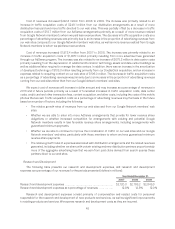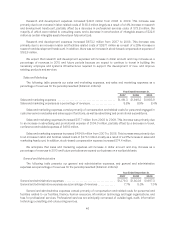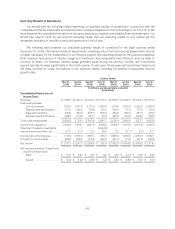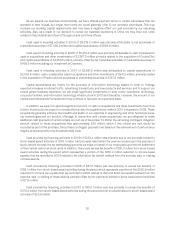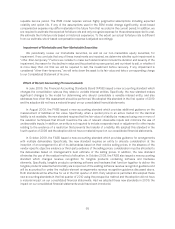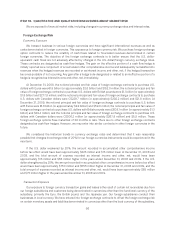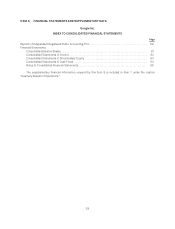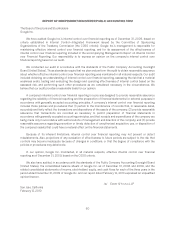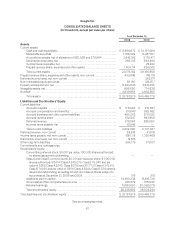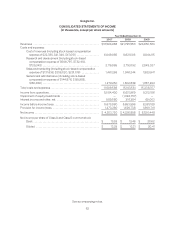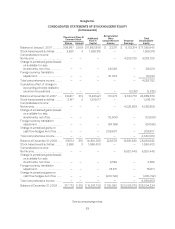Google 2009 Annual Report Download - page 73
Download and view the complete annual report
Please find page 73 of the 2009 Google annual report below. You can navigate through the pages in the report by either clicking on the pages listed below, or by using the keyword search tool below to find specific information within the annual report.requisite service period. The BSM model requires various highly judgmental assumptions including expected
volatility and option life. If any of the assumptions used in the BSM model change significantly, stock-based
compensation expense may differ materially in the future from that recorded in the current period. In addition, we
are required to estimate the expected forfeiture rate and only recognize expense for those shares expected to vest.
We estimate the forfeiture rate based on historical experience. To the extent our actual forfeiture rate is different
from our estimate, stock-based compensation expense is adjusted accordingly.
Impairment of Marketable and Non-Marketable Securities
We periodically review our marketable securities, as well as our non-marketable equity securities, for
impairment. If we conclude that any of these investments are impaired, we determine whether such impairment is
“other-than-temporary.” Factors we consider to make such determination include the duration and severity of the
impairment, the reason for the decline in value and the potential recovery period, and our intent to sell, or whether it
is more likely than not that we will be required to sell, the investment before recovery. If any impairment is
considered “other-than-temporary,” we will write down the asset to its fair value and take a corresponding charge
to our Consolidated Statement of Income.
Effect of Recent Accounting Pronouncements
In June 2009, the Financial Accounting Standards Board (FASB) issued a new accounting standard which
changes the consolidation rules as they relate to variable interest entities. Specifically, the new standard makes
significant changes to the model for determining who should consolidate a variable interest entity, and also
addresses how often this assessment should be performed. We adopted this standard in the first quarter of 2010
and the adoption did not have a material impact on our consolidated financial statements.
In August 2009, the FASB issued a new accounting standard which provides additional guidance on the
measurement of liabilities at fair value. Specifically, when a quoted price in an active market for the identical
liability is not available, the new standard requires that the fair value of a liability be measured using one or more of
the valuation techniques that should maximize the use of relevant observable inputs and minimize the use of
unobservable inputs. In addition, an entity is not required to include a separate input or adjustment to other inputs
relating to the existence of a restriction that prevents the transfer of a liability. We adopted this standard in the
fourth quarter of 2009 and the adoption did not have a material impact on our consolidated financial statements.
In October 2009, the FASB issued a new accounting standard which provides guidance for arrangements
with multiple deliverables. Specifically, the new standard requires an entity to allocate consideration at the
inception of an arrangement to all of its deliverables based on their relative selling prices. In the absence of the
vendor-specific objective evidence or third-party evidence of the selling prices, consideration must be allocated to
the deliverables based on management’s best estimate of the selling prices. In addition, the new standard
eliminates the use of the residual method of allocation. In October 2009, the FASB also issued a new accounting
standard which changes revenue recognition for tangible products containing software and hardware
elements. Specifically, tangible products containing software and hardware that function together to deliver the
tangible products’ essential functionality are scoped out of the existing software revenue recognition guidance and
will be accounted for under the multiple-element arrangements revenue recognition guidance discussed above.
Both standards will be effective for us in the first quarter of 2011. Early adoption is permitted. We adopted these
new accounting standards in the first quarter of 2010 using the prospective method and the adoption did not have
a material impact on our consolidated financial statements. Had we adopted these new standards in 2009, the
impact on our consolidated financial statements would have been immaterial.
55


